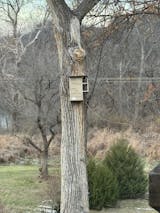What is the American Robin bird?
The American Robin, scientifically known as Turdus migratorius, is a migratory songbird that belongs to the thrush family. It is one of the most widespread and well-known birds in North America.

Where can you find American Robins?
American Robins can be found throughout North America, from Alaska and Canada down to Mexico. They are commonly seen in parks, gardens, forests, and suburban areas.
What do American Robins look like?
Adult American Robins have a distinctive appearance with a reddish-orange breast, gray-brown back, and a white eye ring. They are medium-sized birds with a length of about 9-11 inches. You can differentiate between males and females by the orange color of the breast. Males typically sport a deeper and more vibrant orange, while females are more subdued or faded.

What do American Robins eat?
American Robins are omnivorous birds that primarily feed on insects, earthworms, fruits, and berries. They are known to hop on lawns to search for earthworms, a common sight in many backyards. While robins are not widely considered to be a "feeder bird" they can be attracted to your bird feeder if you provide something desirable to them. Robins may visit a tray-type feeder if mealworms or suet crumbles are offered.

How do American Robins build their nests?
American Robins build cup-shaped nests using grass, twigs, mud, and feathers. They often place their nests in trees, shrubs, or on building ledges, and they are known to re-use their nests for multiple broods. Robin nests can also be somewhat messy looking and may blow out of a tree in a strong enough wind.
Do American Robins migrate?
Yes, American Robins are migratory birds that travel south for the winter. They can be found in large flocks during migration, and they return to their breeding grounds in the spring. One thing to note here - with our weather conditions changing and becoming generally warmer nowadays, the American Robin migratory patterns have shifted. Here in Southern Indiana, for example, we have robins year round now. In the colder months they can be regularly seen flocking together for warmth and protection.
How do American Robins communicate?
American Robins are known for their melodious song, which is a series of clear whistles. They use their songs to establish territories, attract mates, and communicate with other robins. If you have spent some time observing bird behavior in your backyard, you have likely noted that robins are normally the last of the songbirds to turn in at night. As sunset approaches, only the Northern Cardinals, American Robins and occasional Northern Mockingbird remain active. The cardinals will retire next, leaving robins as the last birds awake and singing in the trees.

What are the predators of American Robins?
Common predators of American Robins include domestic cats, hawks, snakes, and raccoons. They are also vulnerable to nest predation by squirrels and other birds. Domestic cats are a threat to pretty much every songbird in your yard. As a precautionary measure if you are a cat owner, you should keep them inside. If not, consider placing bird feeders away from fences and raising them to a level higher than the cat can jump. Hawks, especially the Cooper's Hawk, is a natural predator and there is very little you can do to dissuade them. As for snakes, have you ever seen a rat snake climb a tree? They are extremely good at it! Robins, and especially their eggs, can be fair game to a larger snake. Raccoons are yet another natural predator who has an appetite for bird eggs. When we think about other birds, the Common Grackle comes to mind. These birds will invade a nest and eat the eggs. If you have an active American Robin nest in your yard and grackles make an appearance, look for the the robins to go on the immediate defensive and try to chase them away.

How long do American Robins live?
American Robins have an average lifespan of 2-6 years in the wild. However, some individuals have been known to live up to 14 years in captivity.
How do American Robins protect themselves?
American Robins use various strategies to protect themselves from predators, including mobbing behavior, where they gather in groups to drive away threats. They also rely on camouflage and quick flight to evade danger.

Are American Robins beneficial to the environment?
Yes, American Robins play a crucial role in controlling insect populations and spreading seeds through their diet and foraging behavior. They are considered important contributors to ecosystem health.
Do American Robins mate for life?
American Robins are generally monogamous during the breeding season, but they do not mate for life. They may choose new mates in subsequent breeding seasons.
How can you attract American Robins to your yard?
You can attract American Robins to your yard by providing a water source, planting fruit-bearing trees and shrubs, and offering mealworms or suet in feeders. Creating a bird-friendly environment will make your yard more appealing to these beautiful birds. Also, think "native". While there are many shrubs that might produce enticing berries, only the berries native to your area are truly beneficial to robins - and any other backyard bird for that matter. Berries from non-native plant species may not contain all of the nutrients the birds require and can glean from a native plant.

What is the conservation status of American Robins?
American Robins are abundant and widespread throughout their range, and they are not considered a species of conservation concern. Their populations are stable, and they are protected under the Migratory Bird Treaty Act.
What are you observing in your yard?
As with so many things in nature, "seeing is believing". Bird watching can be fun as well as educational. No matter what all the books (or Google) might say, observing these amazing winged creatures for yourself and learning their behaviors as they inhabit your yard space can be truly rewarding. Add a bird bath and a native berry-producing shrub to your backyard, then get out there and watch!


